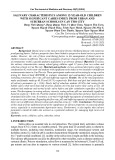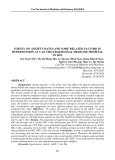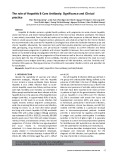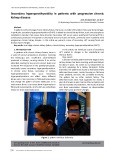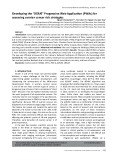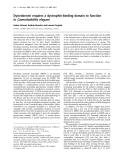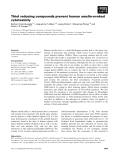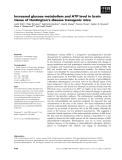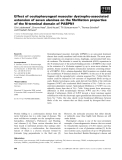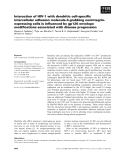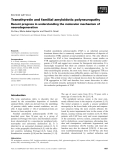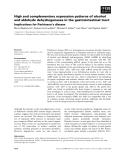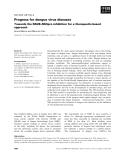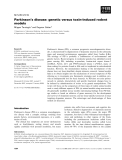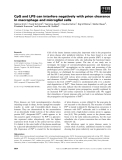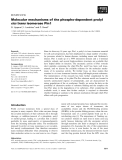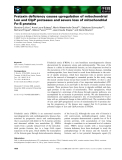
Disease progression
-
Dental caries is the most prevalent chronic childhood disease with numerous predisposing factors. Salivary properties have been linked to progressive dental caries in previous studies. However, the role of these contributing factors in the management of dental caries in children remains insufficient. Thus, the investigation of salivary characteristics from different types of communities within a specific pediatric population is an obvious demand.
 7p
7p  vinara
vinara
 11-01-2025
11-01-2025
 0
0
 0
0
 Download
Download
-
Anxiety disorder is one of the issue that affects the patient's physical and mental health and reduces the effectiveness of treatment. At the moment, patients with underlying conditions, particularly those with hypertension, are more likely to experience anxiety problems. This lessens quality of life, accelerates disease progression, exacerbates illness symptoms, and decreases treatment compliance rates.
 7p
7p  vinara
vinara
 11-01-2025
11-01-2025
 0
0
 0
0
 Download
Download
-
Hepatitis B infection remains a global health problem, with progression to acute-chronic hepatitis, severe liver failure, and death making hepatitis B one of the most serious infections worldwide. The disease is most widely transmitted from an infected mother to her baby, after exposure to infected blood or body fluids or unsafe sexual contact.
 6p
6p  viharuno
viharuno
 03-01-2025
03-01-2025
 1
1
 1
1
 Download
Download
-
In patients with end-stage chronic kidney failure, there are a number of disorders that cause bone damage. In this article we present a case of secondary HPT causing facial and thoracic bone changes.
 6p
6p  viharuno
viharuno
 03-01-2025
03-01-2025
 1
1
 1
1
 Download
Download
-
Early prediction of ovarian cancer has not been given much attention, the application of combined models in clinical practice is not widespread, and the calculation of these models is still difficult due to the complexity and multiple variables.
 8p
8p  viharuno
viharuno
 03-01-2025
03-01-2025
 1
1
 1
1
 Download
Download
-
Schistosomiasis is an endemic disease in Egypt caused by the trematode Schistosoma which has different species. c the best known form of chronic disease with a wide range of clinical manifestations. The pathogenesis of schistosomiasis is related to the host cellular immune response. This leads to granuloma formation and neo angiogenesis with subsequent periportal fibrosis manifested as portal hypertension, splenomegaly and esophageal varices. Intestinal schistosomiasis is another well identified form of chronic schistosomal affection.
 8p
8p  kethamoi1
kethamoi1
 17-11-2019
17-11-2019
 30
30
 2
2
 Download
Download
-
Dystrobrevin is one of the intracellular components of the transmembrane dystrophin–glycoprotein complex (DGC). The functional role of this complex in normal and pathological situations has not yet been clearly established. Dystrobrevin disappears from the muscle membrane in Duchenne muscular dystrophy (DMD), which results from dystrophin mutations, as well as in limb girdle muscular dystrophies (LGMD), which results from mutations affecting other members of the DGC complex.
 6p
6p  system191
system191
 01-06-2013
01-06-2013
 36
36
 5
5
 Download
Download
-
Human amylin (hA) is a small fibrillogenic protein that is the major con-stituent of pancreatic islet amyloid, which occurs in most subjects with type-2 diabetes mellitus (T2Dm). There is growing evidence that hA toxic-ity towards islet b-cells is responsible for their gradual loss of function in T2Dm. Preventing hA-mediated cytotoxicity has been proposed as a route to halt the progression of this disease, although this has not yet been dem-onstratedin vivo.
 11p
11p  fptmusic
fptmusic
 12-04-2013
12-04-2013
 32
32
 2
2
 Download
Download
-
Huntington’s disease (HD) is a progressive neurodegenerative disorder characterized by multifarious dysfunctional alterations including mitochon-drial impairment. In the present study, the formation of inclusions caused by the mutation of huntingtin protein and its relationship with changes in energy metabolism and with pathological alterations were investigated both in transgenic and 3-nitropropionic acid-treated mouse models for HD.
 16p
16p  inspiron33
inspiron33
 23-03-2013
23-03-2013
 38
38
 6
6
 Download
Download
-
Oculopharyngeal muscular dystrophy (OPMD) is an autosomal dominant disease that usually manifests itself within the fifth decade. The most prom-inent symptoms are progressive ptosis, dysphagia, and proximal limb mus-cle weakness. The disorder is caused by trinucleotide (GCG) expansions in the N-terminal part of the poly(A)-binding protein 1 (PABPN1) that result in the extension of a 10-alanine segment by up to seven more alanines.
 10p
10p  inspiron33
inspiron33
 23-03-2013
23-03-2013
 50
50
 4
4
 Download
Download
-
Exposure to quartz particles induces a pathological process named silicosis. Alveolar macrophages initiate the disease through their activation, which is the origin of the later dysfunctions. Ascorbic acid is known to selectively dissolve the quartz surface. During the reaction, ascorbic acid progressively disappears and hydroxyl radicals are generated from the quartz surface. These observations may be relevant to mammalian quartz toxicity, as sub-stantial amounts of ascorbic acid are present in the lung epithelium. ...
 14p
14p  inspiron33
inspiron33
 23-03-2013
23-03-2013
 41
41
 4
4
 Download
Download
-
Dendritic cells can enhance the replication of HIV-1 in CD4 + lymphocytes through the interaction of the gp120 envelope protein with such molecules as dendritic cell-specific intercellular adhesion molecule-3-grabbing noninte-grin. The variable loops of gp120 have previously been shown to modulate the interaction of HIV-1 with its principal receptor CD4 and its various coreceptors, namely CCR5 and CXCR4.
 15p
15p  inspiron33
inspiron33
 23-03-2013
23-03-2013
 42
42
 3
3
 Download
Download
-
Familial amyloidotic polyneuropathy (FAP) is an inherited autosomal dominant disease that is commonly caused by accumulation of deposits of transthyretin (TTR) amyloid around peripheral nerves. The only effective treatment for FAP is liver transplantation.
 14p
14p  galaxyss3
galaxyss3
 21-03-2013
21-03-2013
 50
50
 2
2
 Download
Download
-
Parkinson’s disease (PD) is a heterogeneous movement disorder character-ized by progressive degeneration of dopamine neurons in substantia nigra. We have previously presented genetic evidence for the possible involvement of alcohol and aldehyde dehydrogenases (ADH; ALDH) by identifying genetic variants in ADH1C and ADH4 that associate with PD.
 12p
12p  galaxyss3
galaxyss3
 21-03-2013
21-03-2013
 36
36
 4
4
 Download
Download
-
The LolCDE complex ofEscherichia colibelongs to the ATP-binding cas-sette transporter superfamily and mediates the detachment of lipoproteins from the inner membrane, thereby initiating lipoprotein sorting to the outer membrane. The complex is composed of one copy each of membrane subunits LolC and LolE, and two copies of ATPase subunit LolD.
 17p
17p  galaxyss3
galaxyss3
 19-03-2013
19-03-2013
 32
32
 3
3
 Download
Download
-
Rheumatoid arthritis (RA) is a systemic, chronic inflammatory disease that affects 0.5–1% of the population. RA causes progressive joint destruction that leads to the restriction of activities of daily living and deterioration of quality of life.
 7p
7p  galaxyss3
galaxyss3
 07-03-2013
07-03-2013
 34
34
 3
3
 Download
Download
-
Parkinson’s disease (PD), a common progressive neurodegenerative disor-der, is characterized by degeneration of dopamine neurons in the substantia nigra and neuronal proteinaceous aggregates called Lewy bodies (LBs). The etiology of PD is probably a combination of environmental and genetic factors.
 8p
8p  media19
media19
 06-03-2013
06-03-2013
 27
27
 2
2
 Download
Download
-
Cells of the innate immune system play important roles in the progression of prion disease after peripheral infection. It has been foundin vivo and in vitro that the expression of the cellular prion protein (PrP c ) is up-regu-lated on stimulation of immune cells, also indicating the functional impor-tance of PrP c in the immune system.
 11p
11p  media19
media19
 05-03-2013
05-03-2013
 25
25
 3
3
 Download
Download
-
Since its discovery 10 years ago, Pin1, a prolylcis⁄trans isomerase essential for cell cycle progression, has been implicated in a large number of molecu-lar processes related to human diseases, including cancer and Alzheimer’s disease.
 12p
12p  media19
media19
 04-03-2013
04-03-2013
 23
23
 1
1
 Download
Download
-
Friedreich ataxia (FRDA) is a rare hereditary neurodegenerative disease characterized by progressive ataxia and cardiomyopathy. The cause of the disease is a defect in mitochondrial frataxin, an iron chaperone involved in the maturation of Fe–S cluster proteins.
 12p
12p  vinaphone15
vinaphone15
 27-02-2013
27-02-2013
 32
32
 2
2
 Download
Download
CHỦ ĐỀ BẠN MUỐN TÌM








